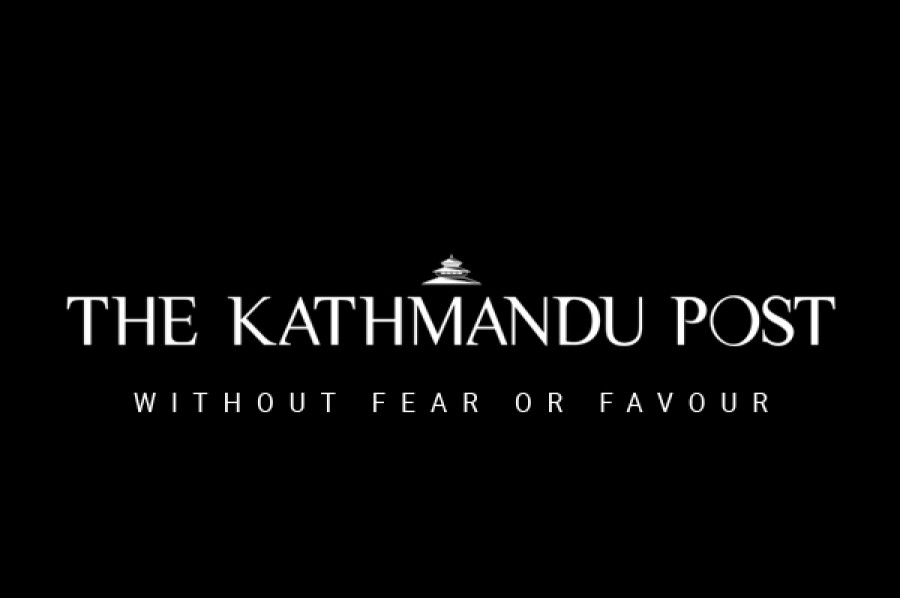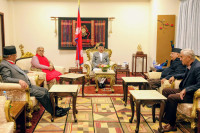Opinion
Dig to preserve
Despite the great archaeological, cultural and religious value of the Chanarbhoga shrine, it remains little known and unearthed
Sanjib Kumar Chaudhary
Chanarbhoga, towards the north of the Rupani-Sambhunath section, houses the ruins of an ancient temple lying helter-skelter in the Chure hills. Remnants of large pillars, temple columns with carved idols, pedestals, large baked bricks, and blocks of sandstones lie unattended. Select temple parts and idols, however, have been collected and placed on a small cave-like dugout in the hill. The villagers from that area consider it the main temple deity.
Despite being a site of great archaeological importance, this place has long been ignored by local authorities and the concerned central government department. The fate of a meticulously carved wall in the north of Kanakpatti village, Saptari, which appeared after torrential rains eroroded the nearby hills, is similar. Locals believe that the wall is connected to the ancient temple in the Chure hills. Many sculptures, bricks, and idols from the area have been swept away by floods and can still be found in the Khando River.
When Sens ruled
Not much has been written and published on the subject, except for a few articles in local newspapers and magazines, let alone research articles on the site. Hari Kant Lal Das, a professor of history from Rajbiraj, in one of his books, says that the ruins in the Chure hills are remnants of Ekagarh, the winter palace of the Sen kings and Chandrabhoga was their clan deity.
At the time of the unification of Nepal, except for Makwanpur in the east, Bijaypur and Chaudandi were under the rule of the Sen kings. Saptari was ruled by Sen kings from Bijaypur in earlier times. Later, after the establishment of Chaudandi, Sen kings ruled from Udaypur in Saptari. As Udaypur used to be cold during the winter, the Sen kings of Chaudandi chose Ambarpur in Saptari as their winter capital. As there are no remains of Ambarpur, it is believed that the area near Sambhunath was once Ambarpur.
Tales of Sabhunath
The columns and idols at Sambhunath are similar to artefacts discovered at Chanarbhoga. The Shiva linga, which is worshipped at Sambhunath, looks like a pillar and unlike other Shiva lingas. Locals sacrifice goats and pigeons to Lord Sambhunath. Bhulai Chaudhary, central advisor of the Tharu Kalyankarini Sabha, claims that Sambhunath is Semnath, the god of the Tharus. Later, the name was Sanskritised to Sambhunath and people started worshipping him as Lord Shiva.
Bouli Chaudhary writes that Chandrabhoga temple was built by King Chandrasen. According to Bouli, Shambhunath and Debnath were brothers and when Sambhunath’s maternal aunt hit him with a larna, a flat ladle-like kitchen equipment used for stirring while roasting food items, he took the form of a stone and asked a man by appearing in his dream to take him away from the place.
When the villagers came to take him away in a bullock cart, he didn’t budge from the place. But when they again brought a small cart meant to be played by children, it started rolling and stopped at the place where the current temple is situated.
Sixty-year old Amrit Lal Chaudhary of Khoksar village corroborates the tale. According to him, the current Shiva linga at Sambhunath was swept away by floods from the Chanarbhoga temple. As it landed in Khando River, shepherds tried sharpening their knives on the abandoned piece of rock. However, the stone bled like a living thing, frightening them away. Later, in a dream of a man from the Sambhunath area, he (Sambhunath) asked the man to take him to the place where the current temple lies these days. The villagers came in groups with drums and musical instruments to receive the god. But he didn’t move when they loaded him into a bullock cart. Once again, the Shiva linga moved only when they put it in a cart meant for children.
Excavate and conserve
Chanarbhoga, though visited by villagers from the surrounding area only once a year, has significant cultural and religious value.
Tharu villages have a Dihibar Than in the south of every village and a Shira Than in the north. Dihibar is the village deity and the Shira Than denotes a worshipping place where Tharus sacrifice goats and pigeons so that they and their cattle are not attacked by wild animals and evil spirits from the jungles. Tharus in the vicinity of Chanarbhoga consider it their Shira Than and make sure to offer a goat to the deity once a year, individually or collectively.
Those seeking to get rid of individual problems go to Chanarbhoga on the first day of Baisakh and offer a goat or pigeon to the deity. The villagers collect beheri, a collective contribution, buy a goat, and offer it to the deity on the same day. This tradition brings all the villagers together on the first day of the year, enhancing harmony amongst them. Though sacrifices are made at the place, it has still not been confirmed whether the deity in the Shira Than are Hindu gods and goddesses. Like Chanarbhoga, there are many Shira Thans in the Chure hills, one being Aginsair in the vicinity of Sitapur village to the east of Chanarbhoga.
In spite of the cultural and religious value of the place, no extensive excavation has been carried out at Chanarbhoga till date. Looking at the similarity of the artefacts at Sambhunath, Chanarbhoga and the carved wall in the north of Kanakpatti village, one can imagine an ancient settlement in the area. While different researchers have different views about Chanarbhoga, it is high time the concerned agencies work to unearth the conundrum lying scattered in the Chure hills.
Chaundhary is communications coordinator at Practical Action. Views expressed are personal and his twitter handle is @sankuchy




 12.12°C Kathmandu
12.12°C Kathmandu











